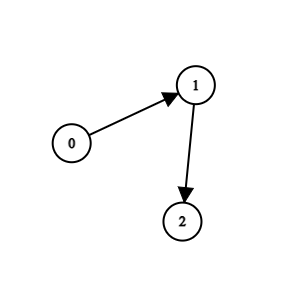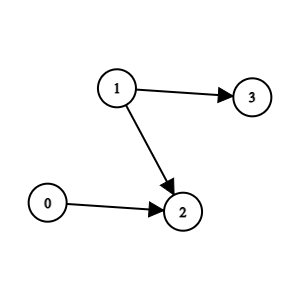找到冠军 II
难度:
标签:
题目描述
There are n teams numbered from 0 to n - 1 in a tournament; each team is also a node in a DAG.
You are given the integer n and a 0-indexed 2D integer array edges of length m representing the DAG, where edges[i] = [ui, vi] indicates that there is a directed edge from team ui to team vi in the graph.
A directed edge from a to b in the graph means that team a is stronger than team b and team b is weaker than team a.
Team a will be the champion of the tournament if there is no team b that is stronger than team a.
Return the team that will be the champion of the tournament if there is a unique champion, otherwise, return -1.
Notes
- A cycle is a series of nodes
a1, a2, ..., an, an+1such that nodea1is the same node as nodean+1, the nodesa1, a2, ..., anare distinct, and there is a directed edge from the nodeaito nodeai+1for everyiin the range[1, n]. - A DAG is a directed graph that does not have any cycle.
Example 1:

Input: n = 3, edges = [[0,1],[1,2]] Output: 0 Explanation: Team 1 is weaker than team 0. Team 2 is weaker than team 1. So the champion is team 0.
Example 2:

Input: n = 4, edges = [[0,2],[1,3],[1,2]] Output: -1 Explanation: Team 2 is weaker than team 0 and team 1. Team 3 is weaker than team 1. But team 1 and team 0 are not weaker than any other teams. So the answer is -1.
Constraints:
1 <= n <= 100m == edges.length0 <= m <= n * (n - 1) / 2edges[i].length == 20 <= edge[i][j] <= n - 1edges[i][0] != edges[i][1]- The input is generated such that if team
ais stronger than teamb, teambis not stronger than teama. - The input is generated such that if team
ais stronger than teamband teambis stronger than teamc, then teamais stronger than teamc.
代码结果
运行时间: 51 ms, 内存: 17.0 MB
/*
题目思路:
使用Java Stream API来实现相同的逻辑,我们可以首先计算每个节点的入度,然后过滤出入度为0的节点。
如果有且只有一个入度为0的节点,那么它就是冠军队伍,否则返回-1。
*/
import java.util.*;
import java.util.stream.*;
public class ChampionTeamStream {
public int findChampion(int n, int[][] edges) {
int[] inDegree = new int[n];
Arrays.stream(edges).forEach(edge -> inDegree[edge[1]]++);
List<Integer> potentialChampions = IntStream.range(0, n)
.filter(i -> inDegree[i] == 0)
.boxed()
.collect(Collectors.toList());
return potentialChampions.size() == 1 ? potentialChampions.get(0) : -1;
}
}解释
方法:
题解通过维护一个包含所有队伍的列表来标记可能的冠军队伍。遍历给定的边,对于每一条边 [u, v],标记 v 队因为存在比它强的 u 队而不可能是冠军,通过将 champion[v] 设为 -1 实现。最后,所有未被标记为 -1 的队伍即是没有比它强的队伍的候选者。如果存在唯一的候选者,则这个候选者是冠军;如果不存在或存在多个,则返回 -1。
时间复杂度:
O(n + m)
空间复杂度:
O(n)
代码细节讲解
🦆
题解中的算法是否考虑了图中潜在的孤立节点,即那些既没有入边也没有出边的节点?
▷🦆
在遍历edges数组时,程序中对champion数组的更新是否可能对后续判断产生先后顺序的影响,比如对于不同顺序的边输入结果是否一致?
▷🦆
如果图中所有的边都是从一个节点指向同一个节点,题解的方法是否还能有效地找出冠军?
▷🦆
题解算法中返回-1的条件是没有冠军或存在多个冠军,那么如何区分这两种情况,是否需要额外的逻辑来明确区分?
▷